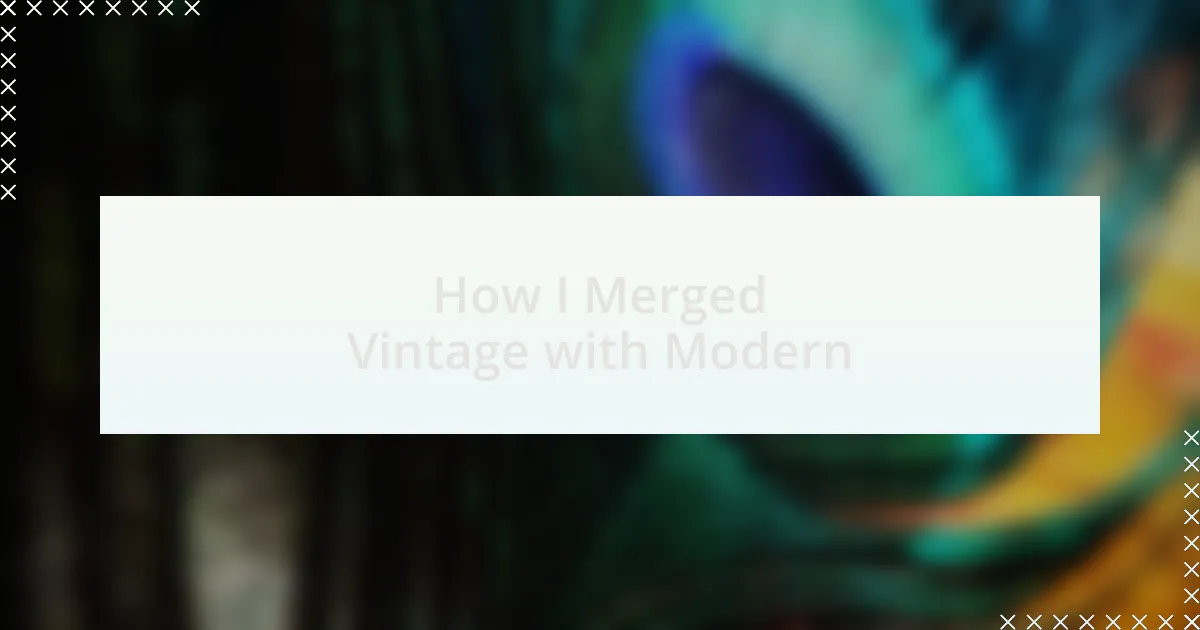Key takeaways:
- Vintage design encapsulates history and emotional connection, while modern design emphasizes simplicity and functionality.
- Merging styles invites creativity, enhances personal expression, and fosters deeper connections through unique narratives.
- Key principles of design fusion include balance, cohesion, and adaptability to create harmonious and functional spaces.
- Effective tips for merging styles involve using a common color palette, selecting impactful statement pieces, and mixing textures for depth.
Author: Oliver Bancroft
Bio: Oliver Bancroft is an accomplished author and storyteller known for his vivid narratives and intricate character development. With a background in literature and creative writing, Oliver’s work often explores themes of human resilience and the complexities of modern life. His debut novel, “Whispers of the Forgotten,” received critical acclaim and was nominated for several literary awards. In addition to his fiction, Oliver contributes essays and articles to various literary magazines. When he’s not writing, he enjoys hiking and exploring the great outdoors with his dog, Max. Oliver resides in Portland, Oregon.
Understanding Vintage and Modern Design
When I first encountered vintage design, I was struck by how it encapsulates history within its aesthetics. There’s something profoundly emotional about a piece that has stories to tell, like an antique chair that carries the marks of its past owners. This connection to the past makes vintage design not just a trend but an experience that resonates deeply with me.
On the other hand, modern design brings a fresh perspective that’s hard to ignore. I remember walking through a contemporary art exhibit, where sleek lines and minimalist features created an inviting space. It made me think—how can simplicity convey such powerful feelings? The clean, functional aspects of modern design strip away distractions, allowing us to focus on what truly matters.
Merging these two styles can feel daunting, but it’s incredibly rewarding. For instance, I once blended vintage lighting fixtures with a sleek, modern dining table. The juxtaposition evoked a beautiful dialogue between eras, creating an inviting atmosphere that sparked conversations. This blend isn’t just about aesthetics; it’s about forging connections—between the past and the present, and between ourselves and the spaces we inhabit.
Importance of Merging Styles
Merging styles is crucial because it invites creativity, allowing us to craft spaces that reflect diverse aspects of our identity. I recall a project where I paired vintage wallpaper with contemporary furniture. The contrast was striking, transforming a plain room into a lively conversation starter. It made me wonder: isn’t our environment a reflection of our experiences and taste?
When different styles come together, they create a unique narrative that transcends time. During a recent renovation, I chose a modern metal sculpture to accentuate a room with vintage wooden beams. The result was astonishing, as it seamlessly connected the rustic charm with contemporary flair, evoking emotions I hadn’t expected. How powerful is it to see history and innovation coexist in harmony?
Embracing this blend isn’t just about aesthetics; it enriches our living spaces. I remember attending a friend’s gathering in a home that beautifully merged mid-century furniture with modern art. It felt inviting and warm, encouraging everyone to share stories about the pieces that surrounded us. Isn’t it amazing how combining styles can lead to deeper connections and conversations?
Key Principles of Design Fusion
Key Principles of Design Fusion
When it comes to design fusion, one principle stands out: balance. I once redecorated my living room by integrating a vintage chandelier with sleek, minimalist lighting fixtures. The juxtaposition created a dialogue between both styles, balancing elegance and simplicity. Isn’t it fascinating how a well-placed piece can harmonize seemingly conflicting elements?
Another principle is cohesion, which ensures that various components work together seamlessly. I remember selecting art pieces that blended both retro and modern styles for my gallery wall. The result was a cohesive narrative that told a story about time and style, inviting guests to engage and interpret the visual dialogue. How often do we overlook the power of a unified theme in our designs?
Lastly, adaptability is essential. I adapted a vintage table into a functional workspace by incorporating modern technology without compromising its charm. This ability to transform and function across eras made the space more versatile. Isn’t it empowering to embrace furniture that tells a story while serving contemporary needs?
Tips for Successfully Merging Styles
One effective tip for merging styles is to start with a common color palette. I once transformed a room by choosing hues that tied together my vintage wood furniture and modern metallic accents. This subtle approach made the space feel united, even with its contrasting elements. Have you ever noticed how the right colors can bridge different eras in design?
Another important strategy is to choose statement pieces wisely. During a recent project, I decided to showcase a vintage rug in an otherwise modern space; it instantly became the focal point, sparking interest and conversation. I find that when you let one item shine, it sets the tone for the entire room without overwhelming the eye. Isn’t it amazing how one piece can shift the vibe so dramatically?
Lastly, don’t shy away from mixing textures. When I combined a sleek leather sofa with a cozy, knitted throw and vintage pillows, the room felt warm and inviting. The different textures created depth, making the space feel layered and interesting. How often do we underestimate the power of touch in our visual experiences?

Leave a Reply